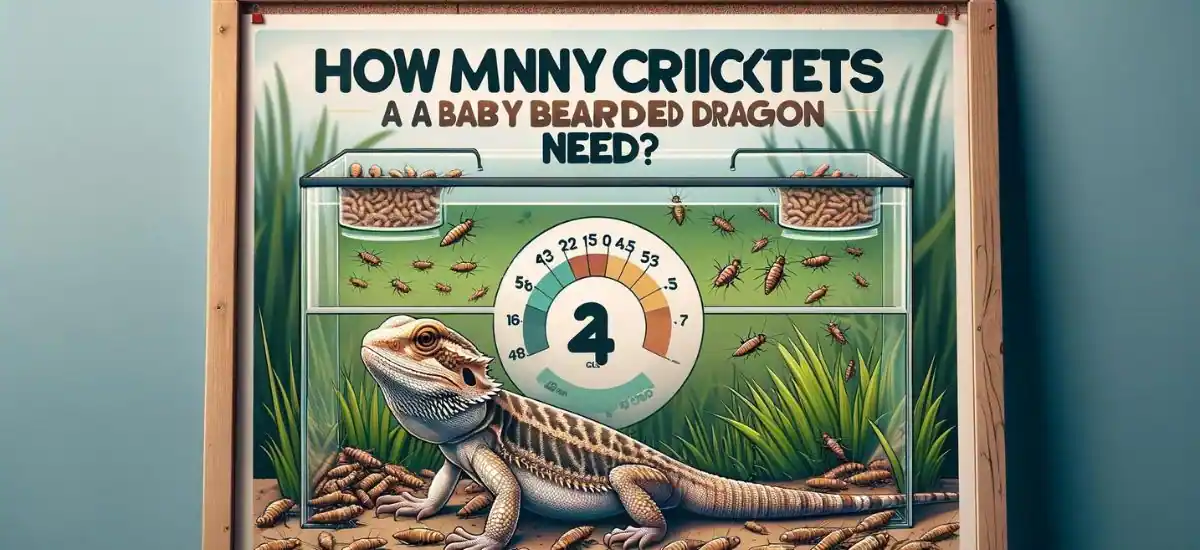Determining how many crickets to feed a baby bearded dragon depends largely on their age, size, and overall health. For a young dragon, aged 0-3 months, feeding about 5-10 small crickets three times a day is ideal. It’s crucial to adjust the amount based on how eagerly your dragon eats and their growth progress. Remember, the goal is to provide enough crickets that they can consume in about 10-15 minutes during each feeding session. This feeding routine ensures your scaly friend grows up healthy and vibrant! ????
Understanding Baby Bearded Dragons
Welcome to the world of baby bearded dragons, where every day is an opportunity for growth and learning! Here’s what you need to know about their early care:
Age Range
- “Baby” bearded dragons are typically classified from hatchling to about five months old. This is a crucial period for setting the foundation of their health.
General Dietary Needs
- Baby bearded dragons are omnivores; early on, their diet should be insect-heavy, with crickets often serving as the main staple.
- Calcium, vitamins, and minerals are vital to prevent common issues like metabolic bone disease.
Importance of a Balanced Diet
- Variety is key. Besides crickets, include other insects like small dubia roaches and finely chopped vegetables such as sweet potatoes, carrots, and leafy greens.
- A diverse diet not only meets nutritional needs but also encourages natural foraging behaviors, essential for their physical and mental development.
Adopting these guidelines will help ensure your baby dragon thrives during its formative months.
Why Crickets? An Overview

Crickets are a popular choice for feeding baby bearded dragons, and for good reason. Here’s a breakdown of why they are beneficial, along with some considerations to keep in mind:
Nutritional Value of Crickets
- Protein-rich: Crickets offer high protein content, which is crucial for the growth and development of baby bearded dragons.
- Natural source of vitamins: They provide essential vitamins such as B12, which supports the nervous system and helps in digestive health.
Benefits of Feeding Crickets
- Encourages natural hunting behavior: The movement of live crickets stimulates the natural predatory instincts of baby bearded dragons.
- Jaw and muscle development: Chasing and chewing crickets helps in the development of jaw strength and overall muscle tone.
Potential Risks and Considerations
- Size matters: The cricket should not be larger than the space between the bearded dragon’s eyes to prevent choking and digestive issues.
- Nutritional balance: While crickets are nutritious, they shouldn’t be the sole item in the diet due to the risk of nutritional imbalances.
- Gut loading: Before feeding crickets to your dragon, it’s important to ‘gut load’ them, which means feeding the crickets nutritious foods that then benefit your pet.
Incorporating crickets into your baby bearded dragon’s diet can greatly benefit their health and development when done with attention to these details.
Determining the Right Amount
When it comes to feeding crickets to your baby bearded dragon, knowing the right amount is crucial for their health and growth. Here’s a guide to help you determine the proper cricket intake:
Factors Influencing Cricket Intake
- Age of the Bearded Dragon: Younger dragons generally require more frequent feedings to support their rapid growth.
- Weight and Length: The amount of food needed is proportional to the dragon’s size; larger dragons may consume more crickets.
- General Health and Activity Level: Active dragons or those in good health may have a higher appetite compared to less active or health-compromised individuals.
Daily Feeding Guide Based on Age and Size

- 0-3 months old: Feed small crickets, about ⅛ inch, 5-10 crickets three times a day.
- 3-6 months old: Increase cricket size to about ¼ inch, feeding 10-20 crickets twice a day.
- 6-12 months old: Transition to larger crickets, feeding 15-20 crickets twice a day.
Always adjust the feeding quantity and frequency based on your dragon’s appetite and growth rate. Monitoring your pet’s response to feeding amounts is key to determining the ideal intake. Remember, the goal is to provide enough crickets that they can consume in about 10-15 minutes during each feeding session without leaving excess crickets that could stress the dragon.
Feeding Schedule and Techniques
Creating an effective feeding schedule and employing the right techniques are key to ensuring your baby bearded dragon’s diet supports their health and well-being. Here’s how to structure feeding times and methods:
How Often to Feed Crickets
- 0-3 months old: Feed three times a day.
- 3-6 months old: Reduce to two times a day as their growth begins to slow.
- 6-12 months old: Continue with twice daily feedings.
Best Times of Day for Feeding
- Morning (shortly after light comes on): Their metabolism is kickstarting, and they are most active.
- Late afternoon/early evening (before lights go off): Ensures they have time to digest before sleeping.
Live Crickets vs. Pre-killed: Pros and Cons
- Live Crickets:
- Pros: Stimulates natural hunting behavior, and enhances mental and physical activity.
- Cons: Risk of crickets biting your dragon if left uneaten.
- Pre-killed Crickets:
- Pros: Safer, especially for less active or younger dragons who might struggle with live prey.
- Cons: Does not encourage natural hunting instincts as effectively.
Tips for Feeding Crickets to Your Dragon
- Use feeding tongs: This avoids accidental bites during hand-feeding and helps control portion sizes.
- Ensure safety: Always remove any uneaten crickets after feeding time to prevent them from causing stress or harm to your dragon while it rests.
- Observe your dragon’s eating habits: This helps in adjusting the feeding process to better suit their preferences and needs.
By following these guidelines, you can create a feeding routine that not only nourishes your baby bearded dragon but also supports their overall health and developmental needs.
Size Matters: Choosing the Right Cricket Size

Selecting the appropriate size of crickets to feed your baby bearded dragon is critical for their safety and digestion. Here’s how to make the best choice:
How to Choose the Correct Cricket Size
- Rule of Thumb: The cricket should be no larger than the space between your bearded dragon’s eyes. This guideline ensures that the cricket can be safely swallowed and digested.
Dangers of Feeding Crickets That Are Too Large
- Choking Hazard: Larger crickets can pose a choking risk to younger or smaller dragons.
- Impaction Risk: Crickets that are too big can lead to digestive blockages, a serious health condition that can be fatal if not addressed.
Recommended Cricket Sizes for Different Ages and Sizes of Baby Dragons
- 0-3 months old: Feed pinhead to ⅛ inch-size crickets, which are small and manageable for hatchlings.
- 3-6 months old: Upgrade to ¼ inch crickets, suitable for dragons that are a bit larger and have more robust digestive capabilities.
- 6-12 months old: Feed ½ inch crickets, appropriate for almost adult dragons who can handle larger prey.
Following these guidelines ensures that your baby bearded dragon receives the appropriate size crickets for their age and size, promoting healthy eating habits and preventing potential health risks.
Supplementing the Diet
Supplementing your baby bearded dragon’s diet is essential to ensure they receive all the necessary nutrients for robust health and growth. Here’s a breakdown of how to effectively supplement their diet:
Importance of Dietary Supplements
- Calcium: Essential for bone health and preventing metabolic bone disease, a common issue in captive bearded dragons.
- Vitamins: Especially vitamin D3, which aids in calcium absorption and overall health. A lack of vitamins can lead to various health problems, including vision issues and immune system deficiencies.
How to Properly Supplement with Crickets
- Dusting: Lightly coat the crickets with a calcium or vitamin powder before feeding. This can be done by placing crickets and supplement powder in a bag and gently shaking it to coat the insects evenly.
- Frequency:
- Calcium should be provided with every other feeding for babies and juveniles to support their rapid growth.
- Vitamin supplements should be given slightly less frequently, about 1-2 times per week, to avoid hypervitaminosis (vitamin overdose).
Other Food Alternatives and Additions to the Diet
- Vegetables: Offer finely chopped leafy greens like collards, mustard greens, and turnip greens, which are high in calcium. Other vegetables like squash, carrots, and sweet potatoes can be offered occasionally.
- Fruits: Small amounts of fruits such as berries, apples, and melon can be given as a treat due to their high sugar content.
- Other protein sources: Besides crickets, include other insects like mealworms, waxworms, and dubia roaches for variety and additional nutrients.
By incorporating these supplements and dietary additions, you’ll ensure your baby bearded dragon maintains optimal health and vitality. Always monitor their reaction to new foods and adjust their diet accordingly to suit their individual needs and preferences.
Troubleshooting Common Feeding Issues

Feeding your baby bearded dragon might come with a few challenges. Here’s how to troubleshoot common feeding issues to ensure your pet maintains a healthy appetite and diet:
What to Do if Your Bearded Dragon Won’t Eat Crickets
- Environmental Stress: Ensure the habitat is comfortable, with proper temperatures and humidity.
- Health Check: Look for signs of illness and consult a veterinarian if the dragon stops eating altogether.
- Variety: Sometimes, offering different types of insects or changing the way you present the food (live vs. pre-killed) can rekindle interest.
Managing Overfeeding and Underfeeding
- Signs of Overfeeding: Watch for sluggish behavior or a distended belly after eating.
- Signs of Underfeeding: Look for visible hip and rib bones or lack of energy.
- Regular Monitoring: Weigh your dragon regularly and adjust meal portions and frequency accordingly to maintain a healthy weight.
Adjusting the Diet as Your Bearded Dragon Grows
- Gradual Changes: As your dragon matures, gradually introduce new foods suitable for their size and age, such as larger crickets and varied vegetables.
- Decrease Protein as They Age: Adult dragons require more vegetables and less protein compared to their juvenile stages.
- Consistent Evaluation: Regularly evaluate your dragon’s health and activity level to determine if dietary adjustments are needed to meet their changing nutritional needs.
By actively monitoring and adapting to your bearded dragon’s dietary needs, you can address feeding issues effectively and ensure your pet thrives in your care.
Frequently Asked Questions
Can baby bearded dragons eat anything other than crickets?
- Yes, in addition to crickets, baby bearded dragons can eat a variety of insects like dubia roaches, waxworms, and mealworms. It’s important to ensure these are appropriately sized for the dragon’s age and size.
How do I know if my baby bearded dragon is getting enough to eat?
- Monitor their energy levels and growth. A well-fed baby dragon should be active, alert, and gradually gaining weight. If you notice any lethargy or weight loss, consider consulting a vet.
What should I do if my baby bearded dragon refuses to eat crickets suddenly?
- First, ensure that the habitat’s temperature and humidity are correct as environmental stress can affect their appetite. If conditions are ideal, try offering different types of food or consult a veterinarian for advice.
Is it necessary to feed baby bearded dragons live food, or can I use frozen alternatives?
- While live food stimulates natural hunting behaviors, frozen or pre-killed food can be a safer option to prevent potential harm from live prey. Ensure that frozen food is completely thawed and warmed to room temperature before feeding.


Leave a Reply
You must be logged in to post a comment.